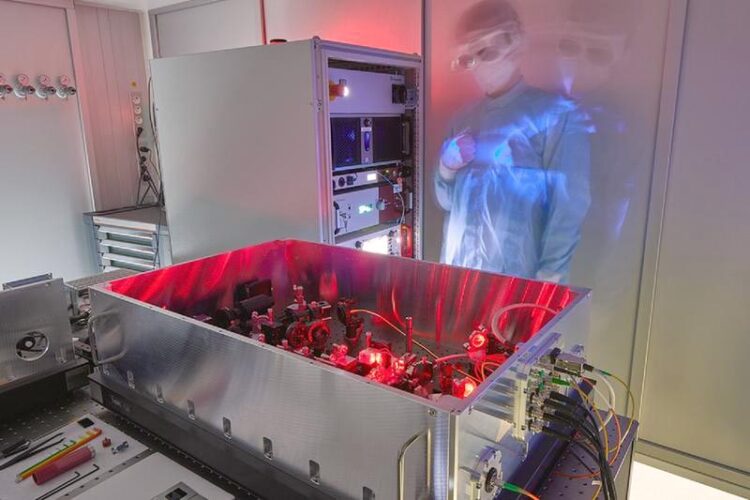Photonic Technologies for the Quantum Internet

New components for networking quantum computers are being tested at Fraunhofer ILT.
© Fraunhofer ILT, Aachen, Germany
Researchers at the Fraunhofer Institute for Laser Technology ILT are developing technology for quantum networks of the future.
Funded by the state of North Rhine-Westphalia, the institute is installing hardware of a network node on location, as it is also used in the quantum internet demonstrator of QuTech in Delft in the Netherlands. The hardware will initially serve as a test and development platform, which the scientists want to use to develop new components for networking quantum computers with partners from industry and research on site in Aachen.
In the future, the node is to be integrated into a European quantum network. Initial results will be presented at the “World of QUANTUM” trade fair in Munich at the end of June.
Quantum technology from Aachen
A focal point for the development of photonic quantum technology is establishing itself in Aachen. To this end, teams from Fraunhofer ILT are working closely with research institutions and companies in the region, in the state of North Rhine-Westphalia, Germany and in Europe. Particularly intensive is the cooperation with QuTech, a joint research institution of the Delft University of Technology and the Dutch Organization for Applied Scientific Research TNO. Fraunhofer ILT and QuTech have collaborated for many years and built a strategic partnership to develop and apply quantum networks and the components required for this.
Quantum Internet Node
Together with partners in Germany and Europe, Fraunhofer ILT scientists want to become leaders in the development of components for the quantum internet. “The quantum internet is about connecting individual quantum computers in different locations,” explains Dr. Bernd Jungbluth, the head of the strategic mission initiative quantum technologies at Fraunhofer ILT. “This is much more complex than just exchanging a quantum key between two points, because many QuBits, the basis of quantum processors, are entangled at different locations.”
In Delft, three nodes have already been successfully connected to each other in the laboratory. They are currently being moved to three locations in the Netherlands, to be subsequently interconnected via the existing fiber optic network. At the same time, the first installation of this kind in Germany is now being built in Aachen, which is taking place as part of the N-Quik funding project. For this project, Mona Neubaur, NRW Minister for Economic Affairs, Industry, Climate Protection and Energy of the state of North Rhine-Westphalia handed over the grant approval for 3.5 million euros to ILT director Constantin Häfner on February 13, 2023.
Components for quantum networks can be tested in this setup, which also serves as a nucleus for establishing an entanglement distribution network in the Rhenish region. Partners from industry and academia can thus develop new products and applications and tap the full potential of distributed quantum computing. “N-Quik makes it possible for us to establish technology and interface standards for quantum information networks and to be involved in setting the European agenda for quantum networking,” explains Bernd Jungbluth.
From QuBit to Quantum Network
The core of the Aachen node is a QuBit based on nitrogen vacancies (NV centers) in diamond. This QuBit serves as the interface of a quantum computer, which provides quantum information by means of photons at 637nm wavelength. In order to transmit this information with low loss over long distances through telecom fibers, a special device comes into play, one previously developed at the Fraunhofer ILT for the quantum Internet demonstrator in Delft: The quantum frequency converter efficiently converts photons entangled with the NV center into the telecom band around 1550 nm, where optical fibers are most transparent, and with low noise. Fraunhofer ILT’s technology sets new standards in this respect. Its signal-to-noise ratio is a hundred times better than the previous state of the art.
“We want to develop and test improved components on the new testbed,” says Bernd Jungbluth, describing the research project in Aachen. This project would also enable the institute to establish new local quantum networks here in the area, for example between Fraunhofer ILT and the Center for Quantum Science and Engineering (CQSE), a project of the Fraunhofer-Gesellschaft with the Forschungszentrum Jülich. In Europe, the Fraunhofer ILT team intends to contribute photonic technologies within the framework of the Quantum Internet Alliance.
From June 27 to 30, experts from the Fraunhofer ILT will be presenting quantum technology, including the quantum frequency converter, at the Fraunhofer joint booth A1.521 in Munich as part of the “World of QUANTUM”, which is part of “LASER World of PHOTONICS,” the world’s largest trade fair for applied photonics.
Wissenschaftliche Ansprechpartner:
Dr. Bernd Jungbluth
Head of the Strategic Program Quantum Technologies at Fraunhofer ILT
Phone +49 241 8906-414
bernd.jungbluth@ilt.fraunhofer.de
Fraunhofer Institute for Laser Technology ILT
Steinbachstraße 15
52074 Aachen, Germany
Weitere Informationen:
https://www.ilt.fraunhofer.de/en.html
https://world-of-photonics.com/en/
Media Contact
All latest news from the category: Information Technology
Here you can find a summary of innovations in the fields of information and data processing and up-to-date developments on IT equipment and hardware.
This area covers topics such as IT services, IT architectures, IT management and telecommunications.
Newest articles

Innovative 3D printed scaffolds offer new hope for bone healing
Researchers at the Institute for Bioengineering of Catalonia have developed novel 3D printed PLA-CaP scaffolds that promote blood vessel formation, ensuring better healing and regeneration of bone tissue. Bone is…

The surprising role of gut infection in Alzheimer’s disease
ASU- and Banner Alzheimer’s Institute-led study implicates link between a common virus and the disease, which travels from the gut to the brain and may be a target for antiviral…

Molecular gardening: New enzymes discovered for protein modification pruning
How deubiquitinases USP53 and USP54 cleave long polyubiquitin chains and how the former is linked to liver disease in children. Deubiquitinases (DUBs) are enzymes used by cells to trim protein…



